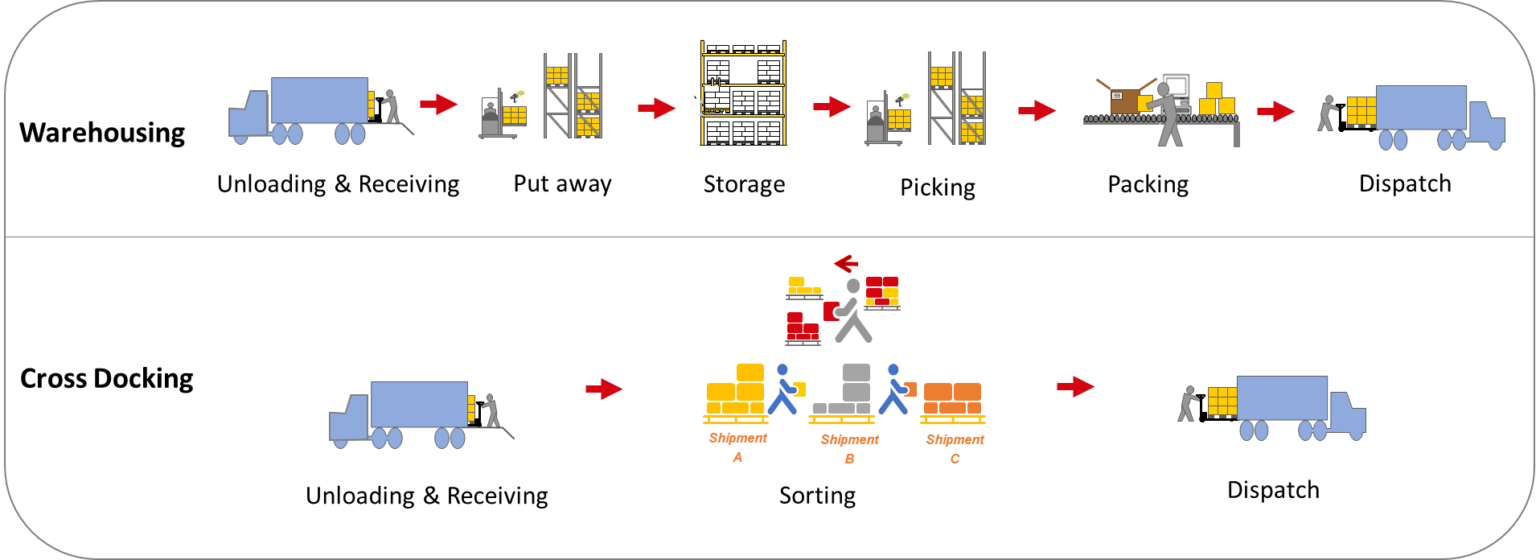Cross-docking is a logistics process where products are directly transferred from incoming to outgoing transportation with minimal or no storage time. To implement cross-docking process effectively, several technology requirements are crucial for smooth operations, optimized efficiency, and real-time data handling. Here’s a breakdown of the key technology requirements
1. Warehouse Management System (WMS)
Role: The WMS is a central system that manages and controls the movement of goods in the warehouse, including incoming and outgoing shipments.
Requirements:
- Real-time tracking: WMS should provide real-time visibility of incoming and outgoing shipments, ensuring efficient allocation and transfer.
- Advanced routing: The system should optimize routes to minimize transportation time and costs.
- Integration with transportation management systems (TMS): Seamless integration allows for efficient communication and coordination between transportation and warehousing.
- Labor management tools: WMS can help manage workforce allocation, track productivity, and identify bottlenecks.
2. Transportation Management System (TMS)
Role: A TMS helps in planning, executing, and optimizing inbound and outbound transportation of goods.
Requirements:
- Scheduling of trucks and optimizing loading/unloading dock assignments.
- Tracking of shipments and route optimization.
- Seamless integration with WMS for synchronization of goods movement.
3. Barcoding and RFID Systems
Role: Barcoding and Radio Frequency Identification (RFID) technology enable automated identification and tracking of products.
Requirements:
- Scanning of products during inbound and outbound processes for real-time data capture.
- RFID tags for quicker identification in high-volume operations.
- Integration with WMS and TMS for instant data updates.
- Product tracking: Labels containing RFID tags can be affixed to products to help identify and trace the cross-docking process automatically.
- Inventory management: Real-time data from RFID tags helps maintain accurate inventory records.
- Security: RFID can be used to track products and prevent theft or loss.

4. Automatic Identification and Data Capture (AIDC) Systems
Role: AIDC encompasses technologies like barcode scanners, mobile handheld devices, and RFID readers to capture and manage data efficiently.
Requirements:
- Efficient scanning and identification of goods moving across docks.
- Handheld mobile devices for warehouse staff to track and process goods in real time.
- Compatibility with WMS for real-time data updates.
- Product identification: Barcode scanners are used to identify products and verify their accuracy against shipping documents.
- Data capture: Barcodes can capture essential information such as product codes, quantities, and destination addresses.
5. Dock Scheduling Systems
Role: Optimizes the scheduling and management of loading and unloading docks to ensure smooth flow of goods.
Requirements:
- Real-time monitoring of dock availability.
- Automated scheduling of trucks to docks based on priority and product movement.
- Communication with WMS and TMS for seamless goods flow.
- Appointment management: This software helps schedule incoming and outgoing trucks to optimize dock utilization.
- Communication: Dock scheduling software can facilitate communication between carriers, shippers, and receivers.
6. Automated Sorting Systems
Role: These systems enable the automatic sorting and routing of products from inbound to outbound docks without manual intervention.
Requirements:
High-speed conveyors, sorters, or pick-and-place systems that can efficiently sort goods based on their destination.
- Sensors and scanners for accurate product identification and sorting.
- Integration with WMS for product data and routing information.
7. Electronic Data Interchange (EDI)
Role: EDI allows businesses to exchange shipping information, purchase orders, and invoices with suppliers, carriers, and retailers in a standardized format.
Requirements:
- Support for real-time data exchange between suppliers, transportation providers, and customers.
- Integration with WMS, TMS, and other supply chain systems to enable seamless communication and document exchange.
- Ensures accurate order fulfillment and real-time updates on shipment status.
8. Real-Time Location Systems (RTLS)
Role: RTLS helps track the movement of goods and vehicles within the warehouse or distribution center in real time.
Requirements:
- Wireless sensors (Wi-Fi, RFID, Bluetooth) to track the location of pallets, trucks, or packages.
- Visibility into the location of items to streamline unloading and loading.
- Real-time data integration with WMS for dynamic decision-making.
9. Data Analytics and Reporting Tools
Role: These tools help monitor key performance indicators (KPIs) and analyze operational efficiency.
Requirements:
- Real-time dashboards showing cross-docking performance metrics such as dock utilization, order accuracy, and throughput times.
- Integration with other systems (WMS, TMS) to gather and analyze operational data.
- Predictive analytics to improve scheduling and resource allocation.
10. Cloud Integration and IoT
Role: Cloud-based systems and IoT sensors allow for scalable, real-time data sharing and remote monitoring of operations.
Requirements:
- IoT sensors for monitoring the condition of goods (temperature, humidity) and vehicle locations.
- Cloud integration for real-time data accessibility across multiple locations.
- Enhanced collaboration between suppliers, carriers, and distribution centers.
11. Automated Guided Vehicles (AGVs)
Role: AGVs can be used to move goods across the warehouse from the inbound to outbound area without human intervention.
Requirements:
- Real-time communication with WMS for movement instructions.
- Sensors for safe navigation and collision avoidance.
- Suitable for high-volume cross-docking operations to speed up product movement.
- Material handling: AGVs can transport materials efficiently within the cross-docking facility, reducing manual labor and improving productivity.
- Flexibility: AGVs can be programmed to follow specific routes and adapt to changing conditions.
12. Security and Access Control Systems
Role: Cross-docking operations require secure access to prevent theft or loss of products.
Requirements:
- CCTV and surveillance systems for monitoring loading and unloading areas.
- Secure access control for dock areas to ensure only authorized personnel can handle products.
- Integration with WMS for monitoring inventory levels and product movement.
13. Voice-Directed Systems
- Hands-free operations: Voice-directed systems guide workers through tasks using voice commands, freeing their hands for other activities.
- Accuracy: Voice commands can reduce errors and improve efficiency.
Conclusion
Technology plays a vital role in ensuring the efficiency, accuracy, and speed of cross-docking operations. Key technologies include WMS and TMS for data management, barcoding/RFID for product tracking, and automation tools like AGVs and sorting systems for enhanced throughput. Real-time data exchange and integration across various systems ensure seamless operations, while cloud, IoT, and analytics enable better decision-making and optimization in real time.

We have been offering extensive and well-planned pieces of training in the field of economics, supply chain, and operations management. Our core purpose is to help industry professionals and businesses to succeed in an ever-evolving competency in the jobs market. Our cutting-edge training methods and up-to-date knowledge aligned with the latest industry trends and demands put our candidates in the lead amongst other job seekers and competitors in the market.
- BRASI Editorial Team#molongui-disabled-linkSeptember 3, 2024
- BRASI Editorial Team#molongui-disabled-linkOctober 8, 2024
- BRASI Editorial Team#molongui-disabled-link





